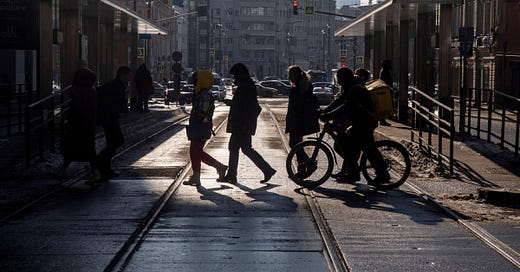Russia's dire demographic situation exposes a deeply dysfunctional society
Dismally low life expectancy in Russia - even before Putin launched his war in Ukraine - undermines the country's outward appearance of strength.
In 1976, the young French academic Emmanuel Todd made a bold claim. In his book, La Chute Finale (or The Final Fall), he argued that, despite its outward appearance of strength, the USSR was in fact rotten to its core. Todd went on to state that, “In ten, twenty or thirty years, an astonished world will be witness to [its] dissolution”. Less than 15 years later, his prediction came true.
Todd came to this conclusion by disregarding the usual short-term indicators that other experts studied, such as economic output and military strength, and instead focusing on something more fundamental: changes in the country’s demographic data. In particular, Todd pointed to the marked increases in the rates of suicide and infant mortality as evidence of the deep dysfunction at the heart of the Soviet system.
Some critics have since dismissed Todd's prediction as little more than a lucky guess. Others point to his modern-day, as yet unfulfilled predictions that Russia will succeed in its war aims in Ukraine, as evidence that he should not be taken entirely seriously. Nonetheless, his earlier book raises interesting questions about how we can use demographic data to understand what is really going on in other countries.
When we survey the contemporary geopolitical landscape through this lens, one country stands out especially: Russia. Despite possessing all the usual trappings of great power status - a multi-trillion dollar economy, a large nuclear arsenal and a permanent seat on the UN Security Council - Russia’s demographic situation is dire.
Average male life expectancy in Russia is currently just 67 years, compared to 79 in the UK and 80 in France. In 2019, a 15 year-old boy in Russia had a 29 per cent chance of dying before the age of 60, compared to a 9 per cent chance in neighbouring Finland. Life expectancy for men is so bad that that Russian teenage boys could move to Iraq, and dramatically increase their chance of reaching old age. It should also be noted that this is based on data for 2019, before the Covid pandemic and prior to Putin's decision to sacrifice many hundreds of thousands of his country’s young men in the pursuit of re-establishing the Russian empire. Since then, the figures have gotten even worse.
There are many reasons why living in Russia is so dangerous. The country has high rates of suicide, homicide and accidental deaths. Russian men also engage in high-risk behaviours, especially binge drinking and smoking strong, unfiltered cigarettes. There is also the traumatic legacy of the collapse of the Soviet Union, which threw the country’s health and social care systems into chaos.
Nonetheless, much of the blame lies with Putin and his government. Despite being blessed with vast natural resources, decades of graft and mismanagement mean that little of this wealth has been used to improve the lives of its citizens. Despite sharing the same history of communist rule, male life expectancy in neighbouring Estonia is eight years higher.
This is not the only demographic challenge facing modern Russia. The decade of turbulence and uncertainty which followed the collapse of the USSR also led to a huge decrease in the birth rate, as many young people in Russia were no longer willing, or financially able, to have children. By 1999, the total fertility rate in Russia had fallen to just 1.18 children per woman, almost half the 2.1 children per woman “replacement fertility” level required to maintain a stable population. While the birth rate has since increased, it has remained low compared to many other European states.
The effect of this is that Russia’s population is likely to have peaked at 146m in 2020, and is now projected to enter a long period of decline. Over the next 30 years, its population is projected to shrink by over 300,000 people each year. This will be a huge headwind for the Russian economy, as fewer people mean fewer workers and fewer consumers.
Russia is not alone in being projected to experience depopulation. However, its vast size and low population density - especially in the countryside - means that the impact will be felt hard. Vast swathes of country could end up virtually uninhabited, as rural areas enter a death spiral where the young move to cities to find work, and the elderly die off. There are already 20,000 abandoned villages in Russia, and a further 36,000 have fewer than ten inhabitants, and these numbers will likely increase further.
Putin is deeply concerned about the dire state of Russia’s population. In recent years, the government has tried to boost the fertility rate by introducing financial incentives to have more children, and even banning what it considers to be propaganda promoting a child-free lifestyle. Some commentators have even argued that the decision to invade Ukraine was partly driven by a desire to increase Russia’s population, by forcibly incorporating a neighbouring people into its own.
Putin is right to be worried. Nearly fifty years after Todd made his prediction about the collapse of the USSR, the demographic data again reveal the shaky foundations of Russia’s power. While Putin’s regime may appear solid for now, things can change quickly, as the recent fall of Assad in Syria reminds us. In several years time, we may come to realise how just how brittle the Russian state really was.
James Rose is a freelance writer specialising in demographics and politics. His work has previously appeared in The Times, The New European, The Big Issue and Politics.co.uk.





